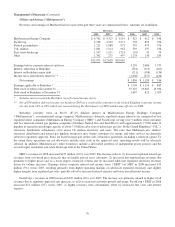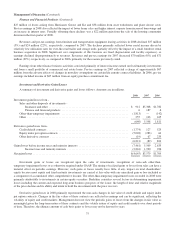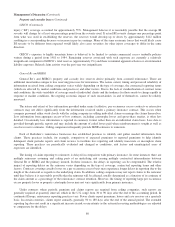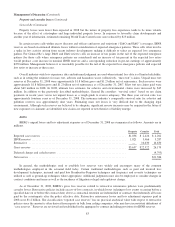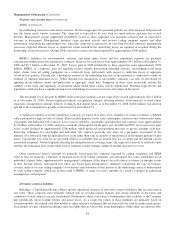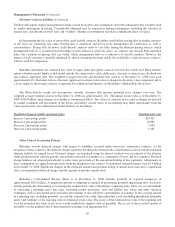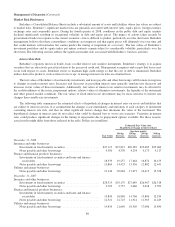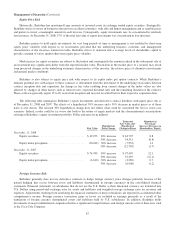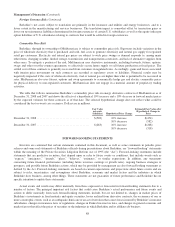Berkshire Hathaway 2008 Annual Report Download - page 81
Download and view the complete annual report
Please find page 81 of the 2008 Berkshire Hathaway annual report below. You can navigate through the pages in the report by either clicking on the pages listed below, or by using the keyword search tool below to find specific information within the annual report.Management’s Discussion (Continued)
Property and casualty losses (Continued)
GEICO (Continued)
GEICO predominantly writes private passenger auto insurance which has a relatively short claim-tail. The key assumptions
affecting GEICO’s reserves include projections of ultimate claim counts (“frequency”) and average loss per claim (“severity”),
which includes loss adjustment expenses.
GEICO’s reserving methodologies produce reserve estimates based upon the individual claims (or a “ground-up”
approach), which yields an aggregate estimate of the ultimate losses and loss adjustment expenses. Ranges of loss estimates are
not determined in the aggregate.
Actuaries establish and evaluate unpaid loss reserves using recognized standard actuarial loss development methods and
techniques. The significant reserve components (and percentage of gross reserves) are: (1) average reserves (20%), (2) case and
case development reserves (55%) and (3) IBNR reserves (25%). Each component of loss reserves is affected by the expected
frequency and average severity of claims. Such amounts are analyzed using statistical techniques on historical claims data and
adjusted when appropriate to reflect perceived changes in loss patterns. Data is analyzed by policy coverage, rated state,
reporting date and occurrence date, among other factors. A brief discussion of each reserve component follows.
Average reserve amounts are established for reported auto damage claims and new liability claims prior to the development
of an individual case reserve. The average reserves are established as a reasonable estimate for incurred claims for which claims
adjusters have insufficient time and information to make specific claim estimates and for a large number of minor physical
damage claims that are paid within a relatively short time after being reported. Average reserve amounts are driven by the
estimated average severity per claim and the number of new claims opened.
Claims adjusters generally establish individual liability claim case loss and loss adjustment expense reserve estimates as
soon as the specific facts and merits of each claim can be evaluated. Case reserves represent the amounts that in the judgment of
the adjusters are reasonably expected to be paid in the future to completely settle the claim, including expenses. Individual case
reserves are revised as more information becomes known.
For most liability coverages, case reserves alone are an insufficient measure of the ultimate cost due in part to the longer
claim-tail, the greater chance of protracted litigation and the incompleteness of facts available at the time the case reserve is
established. Therefore, additional case development reserve estimates are established, usually as a percentage of the case reserve.
As of December 31, 2008, case development reserves averaged approximately 20% of total established case reserves. In general,
case development factors are selected by a retrospective analysis of the overall adequacy of historical case reserves. Case
development factors are reviewed and revised periodically.
For unreported claims, IBNR reserve estimates are calculated by first projecting the ultimate number of claims expected
(reported and unreported) for each significant coverage by using historical quarterly and monthly claim counts to develop
age-to-age projections of the ultimate counts by accident quarter. Reported claims are subtracted from the ultimate claim
projections to produce an estimate of the number of unreported claims. The number of unreported claims is multiplied by an
estimate of the average cost per unreported claim to produce the IBNR reserve amount. Actuarial techniques are difficult to
apply reliably in certain situations, such as to new legal precedents, class action suits or recent catastrophes. Consequently,
supplemental IBNR reserves for these types of events may be established through the collaborative effort of actuarial, claims
and other management.
For each of its major coverages, GEICO tests the adequacy of the total loss reserves using one or more actuarial projections
based on claim closure models, paid loss triangles and incurred loss triangles. Each type of projection analyzes loss occurrence
data for claims occurring in a given period and projects the ultimate cost.
Loss reserve estimates recorded at the end of 2007 developed downward by approximately $205 million when reevaluated
at December 31, 2008 producing a corresponding increase to pre-tax earnings in 2008. These downward reserve developments
represented approximately 2% of earned premiums in 2008 and approximately 3% of the prior year-end reserve amount.
Reserving assumptions at December 31, 2008 were modified appropriately to reflect the most recent frequency and severity
results. Future reserve development will depend on whether frequency and severity turn out to be more or less than anticipated.
Within the automobile line of business the reserves with the most uncertainty are for liability coverages, due to the longer
claim-tails. Approximately 90% of GEICO’s reserves as of December 31, 2008 were for automobile liability, of which bodily
79



